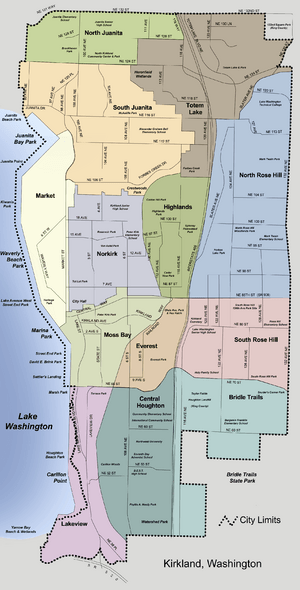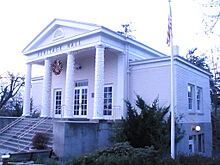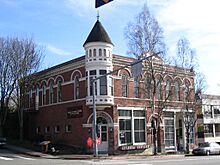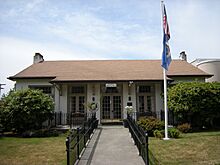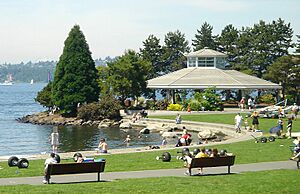Kirkland, Washington facts for kids
Quick facts for kids
Kirkland
|
||
|---|---|---|
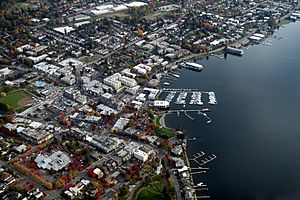
The downtown waterfront area of Kirkland, on the shores of Lake Washington
|
||
|
||
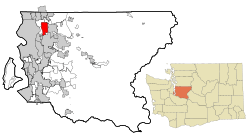
Location of Kirkland within King County, Washington, and King County within Washington
|
||
| Country | United States | |
| State | Washington | |
| County | King | |
| Founded | 1888 | |
| Incorporated | 1905 | |
| Government | ||
| • Type | Council–manager | |
| • Body | City council | |
| Area | ||
| • Total | 22.66 sq mi (58.69 km2) | |
| • Land | 17.81 sq mi (46.12 km2) | |
| • Water | 4.86 sq mi (12.58 km2) | |
| Elevation | 14–500 ft (4–152 m) | |
| Population
(2020)
|
||
| • Total | 92,175 | |
| • Estimate
(2023)
|
91,194 | |
| • Rank | US: 370th WA: 13th |
|
| • Density | 5,176.6/sq mi (1,998.3/km2) | |
| Time zone | UTC−8 (Pacific) | |
| • Summer (DST) | UTC−7 (Pacific) | |
| ZIP codes |
98033, 98034, 98083
|
|
| Area code(s) | 425 | |
| FIPS code | 53-35940 | |
| GNIS feature ID | 1512352 | |
Kirkland is a city in King County, Washington, United States. It's a suburb located east of Seattle. In 2020, its population was 92,175, making it the sixth largest city in King County. It was also the twelfth largest city in the state of Washington.
The city's downtown area is right on the waterfront. You can find many restaurants, art galleries, and public parks there. There are also beaches and a collection of public art, including cool bronze sculptures.
Kirkland was once the home of the Seattle Seahawks, an NFL team. Their main office and training area were located near Lake Washington for their first ten seasons (1976–1985). Later, they moved to nearby Northwest University until 2007. The big warehouse store Costco also used to have its main office in Kirkland. Even though Costco is now in Issaquah, the city of Kirkland is still the name behind their popular "Kirkland Signature" store brand.
Contents
History of Kirkland
The land around Lake Washington was first home to Native American people called the Duwamish people. They were also known as the "Tahb-tah-byook." Many of them lived between Yarrow Bay and Juanita Bay, where they could find lots of wildlife, like waterfowl, to live off. Sadly, diseases like smallpox greatly reduced the number of local Native Americans. Later, changes to Lake Washington, like lowering the water level for the Ship Canal in 1916, caused their population to decline even more.
English settlers started arriving in the late 1860s. The McGregor and Popham families built their homes in what is now the Houghton neighborhood. About 4 miles (6.4 km) north, other people settled near Juanita Bay. This was a favorite spot for the Native Americans because a wild potato, called "wapato," grew well there. More families, like the Curtises and the French family, arrived in the 1870s. The Forbes family settled in what is now Juanita Beach Park in 1876. By the late 1880s, small communities focused on logging, farming, and boat building had grown.
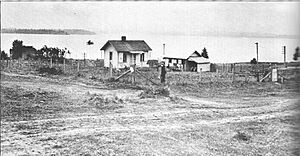
In 1886, Peter Kirk, a businessman from Britain, came to Washington. He wanted to expand his family's steel company. He heard that iron had been found in the Cascade Range. Other things needed for making steel, like limestone, were also easy to find nearby. Plus, there were already some coal mines (which provide fuel for steel mills) in Newcastle, and train tracks were being built. There were also plans for the Lake Washington Ship Canal.
Kirk realized that a town built near the water would be like a freshwater port to the sea. This would also help support any future steel mill. However, Kirk was not a U.S. citizen and couldn't buy land. Leigh S. J. Hunt, who owned a newspaper called the Seattle Post-Intelligencer, offered to work with Kirk. Hunt bought the land they needed.
In July 1888, Kirk and Hunt started a new company called the Kirkland Land and Development Company. They bought thousands of acres of land where downtown Kirkland is now. Soon after, Kirk and his partners began building a new steel mill. It was called the Moss Bay Iron and Steel Company of America. Kirk founded the city of Kirkland in 1888, making it one of the first towns on the Eastside. His dream of a "Pittsburgh of the West" (a big steel-making city) was starting to come true. They began building brick homes and businesses for the steel mill workers.
However, the railroad company, which was now owned by a company in Tacoma, refused to build a rail line to the lake. Tacoma was competing with Seattle to be the main port in Puget Sound. This caused money problems for Kirk, and he started losing investors. Hunt also had debts from buying the land.
Despite these problems, the steel mill was finished in late 1892 on Rose Hill, about 2 miles (3.2 km) from the lake. But because of a financial crisis called the Panic of 1893, the mill closed without ever making any steel. Even so, Kirk didn't give up on his town. Kirkland was finally officially made a city in 1905, with about 532 people. There was one more attempt to build a steel mill in Kirkland in 1906, but it also didn't happen.
In 1900, the Curtis family ran a business building ferries on Lake Washington. Along with Captain John Anderson, they were among the first to operate ferries in the area. The Leschi was the first wooden ferry. It started carrying cars and people between the Eastside and Madison Park on December 27, 1913. It operated until 1950. Ferries ran almost continuously for 18 hours a day. But when the first Lake Washington floating bridge was built in 1940, ferry service became too expensive and eventually stopped. In later years, making wool and building warships became important industries.
The first woolen mill in Washington state was built in Kirkland in 1892. This mill made most of the wool products for people going to the Klondike Gold Rush and for the U.S. military during World War I. After the Lake Washington Ship Canal was finished in 1917, building large ocean-going ships became a big business. By 1940, the busy Lake Washington Shipyard had built more than 25 warships for the U.S. Navy during World War II. This shipyard was located where Carillon Point is today.
How Kirkland Grew: Annexations
Since Kirkland became a city in 1905, it has grown a lot. Its size is now about 12 times bigger than it was originally! It almost doubled in size during the 1940s and 1960s.
On July 31, 1968, Kirkland joined with the nearby town of Houghton. This made one city with 13,500 people. In 1974, Kirkland added the Totem Lake neighborhood. In 1988, it added South Juanita, North Rose Hill, and South Rose Hill. These were the biggest additions of land in Washington in almost 20 years. These additions brought 16,119 more people to Kirkland. They were responsible for 76 percent of Kirkland's population growth between 1980 and 1990.
In 2009, people in three areas north of the city—Finn Hill, North Juanita, and Kingsgate—voted to join Kirkland. This was part of a plan to encourage cities to grow. The vote didn't quite reach the 60% needed to take on the city's debt. However, since more than 50% voted yes, the city council decided to accept the annexation without the debt.
This addition brought 33,000 new residents and almost 7 square miles (18 km2) to Kirkland on June 1, 2011. For ten years, from 2011 to 2021, the city received special money from the State of Washington. This money helped cover the costs of providing city services to these new areas.
Geography and Climate
Kirkland is located on the west side of Lake Washington. To its east is Redmond, to the south is Bellevue, and to the north are Kenmore, Woodinville, and Bothell. The city's downtown area is along Moss Bay on Lake Washington. It has a business district, restaurants, art galleries, and parks. Downtown Kirkland and the Moss Bay neighborhood have many apartments and condos, mostly built since the 1990s. Kirkland is one of the most crowded suburban cities in Washington, with more people living closer together than in most other Eastside cities.
You can get to Kirkland using Interstate 405. This highway connects Kirkland to other Eastside cities like Bellevue, Renton, and Bothell. Seattle, which is across Lake Washington to the west, and Redmond to the east, can be reached using State Route 520.
The city covers a total area of about 17.83 square miles (46.18 km2). Most of this is land (17.818 sq mi or 46.15 km2), with a small amount of water (0.012 sq mi or 0.03 km2). The city's elevation, or height above sea level, ranges from 14 to 500 feet (4 to 152 meters).
Kirkland's Climate
Kirkland has an average temperature of 52°F (11°C). The city gets about 36.27 inches (921 mm) of rain each year. The hottest temperature ever recorded was 109°F (43°C) on June 28, 2021. The coldest temperature ever recorded was -5°F (-21°C) in January 1950.
| Climate data for Kirkland, Washington | |||||||||||||
|---|---|---|---|---|---|---|---|---|---|---|---|---|---|
| Month | Jan | Feb | Mar | Apr | May | Jun | Jul | Aug | Sep | Oct | Nov | Dec | Year |
| Record high °F (°C) | 66 (19) |
70 (21) |
79 (26) |
90 (32) |
94 (34) |
109 (43) |
103 (39) |
101 (38) |
100 (38) |
89 (32) |
74 (23) |
64 (18) |
109 (43) |
| Mean daily maximum °F (°C) | 43 (6) |
47 (8) |
54 (12) |
59 (15) |
64 (18) |
70 (21) |
77 (25) |
78 (26) |
71 (22) |
61 (16) |
52 (11) |
45 (7) |
60 (16) |
| Daily mean °F (°C) | 38 (3) |
41 (5) |
47 (8) |
50 (10) |
55 (13) |
61 (16) |
66 (19) |
67 (19) |
62 (17) |
53 (12) |
46 (8) |
38 (3) |
52 (11) |
| Mean daily minimum °F (°C) | 33 (1) |
36 (2) |
39 (4) |
42 (6) |
47 (8) |
53 (12) |
56 (13) |
57 (14) |
52 (11) |
46 (8) |
40 (4) |
34 (1) |
45 (7) |
| Record low °F (°C) | −5 (−21) |
−3 (−19) |
11 (−12) |
28 (−2) |
29 (−2) |
37 (3) |
41 (5) |
43 (6) |
34 (1) |
27 (−3) |
5 (−15) |
0 (−18) |
−5 (−21) |
| Average precipitation inches (mm) | 4.81 (122) |
3.43 (87) |
3.51 (89) |
2.77 (70) |
2.16 (55) |
1.63 (41) |
0.79 (20) |
0.97 (25) |
1.52 (39) |
3.41 (87) |
5.84 (148) |
5.43 (138) |
36.27 (921) |
| Average snowfall inches (cm) | 2.0 (5.1) |
2.2 (5.6) |
0.8 (2.0) |
0 (0) |
0 (0) |
0 (0) |
0 (0) |
0 (0) |
0 (0) |
0 (0) |
1.0 (2.5) |
2.1 (5.3) |
8.1 (21) |
People of Kirkland
| Historical population | |||
|---|---|---|---|
| Census | Pop. | %± | |
| 1900 | 264 | — | |
| 1910 | 532 | 101.5% | |
| 1920 | 1,354 | 154.5% | |
| 1930 | 1,714 | 26.6% | |
| 1940 | 2,084 | 21.6% | |
| 1950 | 4,713 | 126.2% | |
| 1960 | 6,025 | 27.8% | |
| 1970 | 14,970 | 148.5% | |
| 1980 | 18,785 | 25.5% | |
| 1990 | 40,052 | 113.2% | |
| 2000 | 45,054 | 12.5% | |
| 2010 | 48,787 | 8.3% | |
| 2020 | 92,175 | 88.9% | |
| 2023 (est.) | 91,194 | 86.9% | |
| U.S. Decennial Census | |||
In 2019, the average income for a household in Kirkland was $117,190. The average income per person was $63,135.
2020 Population Data
In 2020, there were 92,175 people living in Kirkland.
| Race / Ethnicity (NH = Non-Hispanic) | Pop 2000 | Pop 2010 | Pop 2020 | % 2000 | % 2010 | % 2020 |
|---|---|---|---|---|---|---|
| White alone (NH) | 37,438 | 37,024 | 58,847 | 83.10% | 75.89% | 63.84% |
| Black or African American alone (NH) | 688 | 805 | 1,842 | 1.53% | 1.65% | 2.00% |
| Native American or Alaska Native alone (NH) | 211 | 148 | 252 | 0.47% | 0.30% | 0.27% |
| Asian alone (NH) | 3,497 | 5,465 | 16,387 | 7.76% | 11.20% | 17.78% |
| Pacific Islander alone (NH) | 83 | 123 | 164 | 0.18% | 0.25% | 0.18% |
| Other race alone (NH) | 107 | 241 | 926 | 0.24% | 0.49% | 1.00% |
| Mixed Race or Multi-Racial (NH) | 1,178 | 1,896 | 6,473 | 2.61% | 3.89% | 7.02% |
| Hispanic or Latino (any race) | 1,852 | 3,085 | 7,284 | 4.11% | 6.32% | 7.90% |
| Total | 45,054 | 48,787 | 92,175 | 100.00% | 100.00% | 100.00% |
2010 Population Data
In 2010, there were 48,787 people and 22,445 households in Kirkland. About 24.6% of households had children under 18. The average household size was 2.15 people. The average age in the city was 37.5 years old. About 18.8% of residents were under 18.
Arts and Culture
Kirkland used to have many art galleries downtown. Now, only a few remain, as others have closed or moved. The Kirkland Performance Center hosts many live shows and events. The Kirkland Arts Center, located in the old Peter Kirk Building, offers classes, workshops, and a gallery for local art.
From 2003 to 2011, Kirkland hosted the annual Kirkland Concours d'Elegance. This event showed off classic cars and wooden boats from all over the country. Now, the Porsche Club of America holds an annual Porsche car show at the same location every September.
Kirkland Teen Union Building
The Kirkland Teen Union Building (KTUB) is in downtown Peter Kirk Park. The city and several non-profit groups support it. KTUB has two music stages, a recording studio, a darkroom, and activities for young people all year long.
Sports in Kirkland
The local Lake Washington High School lacrosse team won the state championship in 2015. They beat their rival, Juanita High School, 8–7.
The Lake Washington High School Baseball team won their first-ever State Championship (3A) in 2016. They defeated Lakeside School 2–0.
Kirkland FC is an amateur soccer club. They play in the Western Washington Premier League and started in 2018. Their nickname is the Goats.
Seattle Seahawks Connection
Kirkland was the first home of the Seattle Seahawks. The NFL team's main office and training area were at the Lake Washington Shipyard (now Carillon Point) for their first ten seasons (1976–1985). After that, they moved to nearby Northwest University until 2007.
Little League Baseball
Kirkland has two Little Leagues: Kirkland American Little League and Kirkland National Little League. Kirkland National won the 1982 Little League World Series championship. They beat a team from Taiwan 6–0 on August 28, 1982. This 1982 victory was even featured in an ESPN 30 for 30 documentary called Little Big Men. Kirkland was also home to the 1992 Big League Softball World Series Champions.
The Kirkland Baseball Commission offers recreational baseball for players aged 13–18. It is part of the national Pony Baseball organization.
Since 1999, Kirkland has hosted the Little League Junior Softball World Series. This big event is held every August at Everest Park.
Parks and Outdoor Fun
Kirkland's waterfront parks on Lake Washington are very popular, especially in the summer. Kirkland also has many neighborhood parks. Part of Saint Edward State Park is in Kirkland, and it's next to the Bridle Trails State Park, which is great for horseback riding. The waterfront parks are connected by a gravel trail that is open until dusk. Juanita Beach Park is another major park in Kirkland and a popular spot for visitors. The Cross Kirkland Corridor is a trail built on old train tracks that runs through the middle of the city.
Education in Kirkland
Most of Kirkland is part of the Lake Washington School District. This district also serves other nearby communities. The school district has two high schools within Kirkland: Juanita and Lake Washington. It also operates five middle schools and thirteen elementary schools.
Some parts of Kirkland are in the Bellevue School District, and other parts are in the Northshore School District.
The city is also home to several private schools, like Puget Sound Adventist Academy and Eastside Preparatory School. There are also public magnet schools, which offer special programs. These include the Environmental and Adventure School, International Community School, B.E.S.T. High School, and Northstar Middle School.
Kirkland is where Lake Washington Technical College and Northwest University, a small Christian college, are located. Also, Bastyr University is just outside Kirkland's northwest border, in Kenmore.
Kirkland's Economy
Here are the top employers in Kirkland, based on a 2020 report:
| # | Employer | # of Employees |
|---|---|---|
| 1 | Evergreen Healthcare | 3,726 |
| 2 | Google, Inc. | 2,545 |
| 3 | City of Kirkland | 650 |
| 4 | Tableau Software | 494 |
| 5 | Kenworth Truck Co. | 475 |
| 6 | Astronics Advanced Electronic Systems | 450 |
| 7 | GoDaddy.com | 388 |
| 8 | Lake Washington Institute of Technology | 367 |
| 9 | ServiceNow | 318 |
| 10 | Friend of Youth | 316 |
Media and News
Kirkland gets its news from several sources:
- The Seattle Times: This is the biggest daily newspaper in the Seattle area. It is the official newspaper for the city of Kirkland.
- The Kirkland Reporter: This is an online weekly publication.
- The City Update Newsletter: This is the city's official newsletter. It shares information about city programs, new laws, and neighborhood news.
- Currently Kirkland: This is the city's official video news segment. It airs every two weeks on Kirkland's two local TV stations: K Life and K Gov.
Getting Around Kirkland
Transportation Options
In 2006, Kirkland was the first city in Washington to adopt a "Complete Streets" rule. This means that when they plan road construction or improvements, they must also think about how to make it safe and easy for people walking, biking, and even riding horses. In 2009, Kirkland also created an Active Transportation Plan. This plan specifically aims to improve facilities for walkers, bikers, and horse riders.
Kirkland is served by King County Metro and Sound Transit Express buses. These buses meet in Downtown Kirkland, the Totem Lake neighborhood, and at the South Kirkland Park and Ride. The city also has several park and ride locations along Interstate 405. Buses connect Kirkland to Bellevue, Seattle, Redmond, Bothell, Kenmore, and Woodinville.
As part of a plan called Sound Transit 3, Kirkland is expected to get a short Link light rail line. This line will come from Issaquah and Downtown Bellevue and end at the South Kirkland Park and Ride. It was originally planned to open in 2041, but due to money issues, it is now expected to open in 2044. The Sound Transit 3 plan also includes a bus rapid transit line on Interstate 405. This line will have stops at NE 85th Street and the existing Totem Lake Freeway Station.
Notable People from Kirkland
Many interesting people have connections to Kirkland:
- Dorothy Anstett: Miss Washington USA 1968 and Miss USA 1968
- Mark Arm: Musician in the bands Green River and Mudhoney
- Chris Bingham: Race car driver
- Gail Brodsky: Tennis player
- Mitchie Brusco: Professional skateboarder
- Dori Hillestad Butler: Children's author, lives in Kirkland
- Tobey Butler: Racing driver
- Deb Caletti: Author of young adult and adult fiction
- David DeCastro: Lineman for Pittsburgh Steelers
- Tom Evans: MLB baseball player (Toronto Blue Jays, Texas Rangers)
- Ryan Hall: Retired runner, holds the U.S. half marathon record
- Marion Hutton: Singer and actress
- Ken Lehman: MLB pitcher (Brooklyn Dodgers, Baltimore Orioles, Philadelphia Phillies)
- Ally Maki: Actress
- Rick May: Voice actor and theatrical director and actor
- Michael O'Hearn: Bodybuilder, actor and model
- Evagoras Papasavvas: Racing driver
- Robin Pecknold: Singer, lead songwriter of Fleet Foxes
- Jennie Reed: Champion track cyclist and Olympian (2004, 2008, 2012)
- Cher Scarlett: Software developer and activist
- Travis Snider: MLB baseball player (Toronto Blue Jays, Pittsburgh Pirates, Baltimore Orioles, Arizona Diamondbacks)
- Rosalynn Sumners: World and National champion figure skater, Olympic silver medalist (1984)
- Johnny Whitney: Singer and musician
- Lana Wilson: Filmmaker
Sister City
Kirkland has one sister city:
 Emmerich am Rhein, Germany (since 1995)
Emmerich am Rhein, Germany (since 1995)
See also
 In Spanish: Kirkland (Washington) para niños
In Spanish: Kirkland (Washington) para niños



